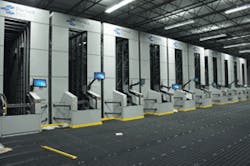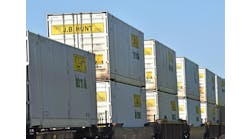Store: Goods-to-Person Picking Meets Order-to-Consumer Demand
Many executives running high-throughput distribution centers face a growing logistics challenge—the need to prepare small-quantity, mixed-SKU orders to ship and arrive on schedule with short delivery times. Fueled by shifting demographics, niche retailing, mobile devices, faster product introductions and shorter product life-cycles, small-quantity, multiple-SKU orders are becoming increasingly difficult to handle by conventional means.
Sometimes comprising thousands or tens-of-thousands of different SKUs and in an assortment of packaging styles, a DC's inventory needs to be stored, picked and shipped with a very high level of efficiency to optimize labor usage and minimize operational costs.
Much of the recent investment in automation for warehouses and distribution centers has been driven by a desire to improve single-piece order picking processes. For high-volume pick order lines, highly automated robotic- and shuttle-based systems provide efficient goods-to-person solutions. These systems can achieve performance levels of many hundreds of order lines per hour with precision accuracy, while operating in a condensed space.
But as distribution requirements continue to evolve, so have the needs of distribution executives, who are increasingly requiring more flexibility, better uptime reliability and improved energy efficiency from their high-throughput goods-to-person picking operations.
Next Generation Picking
A new generation of high-throughput picking solutions was designed as a variation of the scalable, high-density tote racking structures commonly serviced by delivery vehicles. These vehicles extract totes from storage locations and present them to pick stations for order fulfillment.
The new take on this scenario includes a double-ended picking system that requires no elevators, conveyors or transfers. It delivers the tote directly from the rack location to the picking station, without the tote leaving the delivery vehicle.
With traditional shuttle picking technology the shuttle moves down the aisle to a rack location and picks up a tote, pulls it onboard, then again moves down to the end of the aisle where it interfaces to a lift. Here the shuttle is either transported down, or it passes off the tote to be transported down to a lower level where the tote is again transferred off to a conveyor loop, which stages the tote to a picking station. After picking, the tote is then lifted up, transferred over and set back down on another conveyor and sent back into the system. That is one pick cycle. That multi-touch process is repeated hundreds of times per hour with conventional automated shuttle pick systems.
A similar approach is used with robotic pick systems which are required to lift bins vertically to access the desired tote. The selected tote must then be transported to a drop location where the tote is lowered to a pick station. When picking is complete, the tote is elevated back up to a receipt location where a robot transports it back to the bin location where it originated. The robot then drops the tote into the desired bin.
The next generation of goods to person enables a throughput rate of up to 1,000 picking cycles (picking and putting) per hour by eliminating the need for elevators, conveyors or transfers.
Intelligent, wireless vehicles store and retrieve totes within the system's racking structure. Each robotic device can access 100 percent of inventory in the aisle. This differs from conventional shuttle-based goods-to-person systems where each individual shuttle is held captive to a specific row, inhibiting that shuttle's full access to all SKU locations within the aisle.
The new shuttles can roam horizontally or vertically throughout the aisle to reach designated SKU/tote locations and pick stations. Traffic control software, operating in real-time with microspeed response, monitors the position of all shuttles and directs their movements throughout the system for maximum accuracy and efficiency.
When a shuttle carrying a tote is received at a pick station, it can tilt for ergonomic positioning to reduce a worker's stretching or lifting. Text and visual prompts on picking monitors, supported by pick-to-light, direct the operator to choose the required item(s) from the tote, and indicate the appropriate order boxes in which to place them. When the operator indicates the final pick is complete, the software releases the current shuttle and tote, which then returns the tote to its location in the racking structure. The next shuttle/tote is immediately placed into position for the next picking sequence.
Robotic shuttles can provide the ability to pick and replenish simultaneously, and on the fly, as needed.
Depending on SKU counts, throughput volume requirements and number of pick stations, up to 16 shuttles could be deployed per aisle, with each one having access to 100 percent of the aisle inventory.
Energy Efficiency adds Savings
All operational parts within an older automated pick system utilize energy. Aside from the movement of the shuttles themselves, employing the use of lifts, transfers and conveyors to move shuttles and totes throughout the system can present a significant draw on energy.
Simplicity of process operation in automated picking is key to reducing energy usage. Reduce the volume of moving components and the need for energy diminishes. Because the new generation of shuttle systems is designed without lifts, transfers or internal conveyors, there's no added energy draw from such components. The energy required to power vehicles that are moving totes throughout an automated goods-to-person-system represents the bulk of the energy consumed.
Some automated pick systems use rechargeable batteries to power or partially power shuttles and robots to offset energy usage. Batteries depend on chemical activity to generate electricity and require downtime to recharge. That's why some high-speed pick systems are moving to ultra-capacitors. These store energy electrostatically and are designed to last up to10 years.
Shuttles can utilize onboard ultra-capacitors to recapture energy during normal operation of deceleration and descent. The ultra-capacitors can store relatively large amounts of electric charge very rapidly. They are also capable of delivering very large bursts of power in a highly efficient manner.
To match seasonal business flows, the number of shuttle vehicles can be changed. Because they operate independently from the racking system, they can be introduced or removed quickly.
Fast, efficient and accurate delivery is one of the strongest competitive advantages in any market, and streamlined goods-to-person piece-picking provides a critical foundation for achieving this.
Jim McMahon writes on logistics automation. He can be reached at [email protected].




